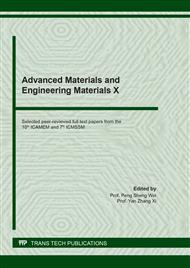[1]
S. Wang, K. Yang, Y. Shan, et al., Plastic deformation and fracture behaviors of nitrogen-alloyed austenitic stainless steels, Materials Science and Engineering: A, 490 (2008) 95-104.
DOI: 10.1016/j.msea.2008.01.015
Google Scholar
[2]
S. Frechard, A. Redjaimia, E. Lach, et al., Mechanical behaviour of nitrogen-alloyed austenitic stainless steel hardened by warm rolling, Materials Science and Engineering: A, 415 (2006) 219-224.
DOI: 10.1016/j.msea.2005.09.070
Google Scholar
[3]
M. Milititsky, D.K. Matlock, A. Regully, et al., Impact toughness properties of nickel-free austenitic stainless steels, Materials Science and Engineering: A, 496 (2008) 189-199.
DOI: 10.1016/j.msea.2008.05.022
Google Scholar
[4]
B. Chang, Z. Zhang, Cyclic deformation behavior in a nitrogen-alloyed austenitic stainless steel in terms of the evolution of internal stress and microstructure, Materials Science and Engineering: A, 556 (2012) 625-632.
DOI: 10.1016/j.msea.2012.07.037
Google Scholar
[5]
C.M. Hong, J. Shi, L.Y. Sheng, et al., Effects of hot-working parameters on microstructural evolution of high nitrogen austenitic stainless steel, Materials and Design, 32 (2011) 3711-3717.
DOI: 10.1016/j.matdes.2011.03.055
Google Scholar
[6]
J.W. Simmon, Overview, high-nitrogen alloying of stainless steels, Materials Science and Engineering A, 207 (1996) 159-169.
DOI: 10.1016/0921-5093(95)09991-3
Google Scholar
[7]
F.B. Pickering, Physical metallurgy of stainless steel developments, International Materials Reviews, 21 (1976) 227-268.
Google Scholar
[8]
M. Milititsky, N.D. Wispelaere, R. Petrov, et al., Characterization of the mechanical properties of low-nickel austenitic stainless steels, Mterials Science and Engineering: A, 498 (2008) 289-295.
DOI: 10.1016/j.msea.2008.08.012
Google Scholar
[9]
S.T. Wang, K. Yang, Y.Y. Shan, et al., Study of cold deformation behaviors of a high nitrogen austenitic stainless steel and 316L stainless steel, Acta Metallrgica Sinica-Chinese Edition, 43 (2007) 171.
Google Scholar
[10]
S. Frechard, A. Redjaimia, E. Lach, et al., Dynamical behaviour and microstructural evolution of a nitrogen-alloyed austenitic stainless steel, Materials Science and Engineering: A, 480 (2008) 89-95.
DOI: 10.1016/j.msea.2007.07.014
Google Scholar
[11]
E. Lach, C. Anderson, V. Schirm, et al., Hypervelocity impact into a high strength and ductile steel alloy, International Journal of Impact Engineering, 35 (2008) 1625-1630.
DOI: 10.1016/j.ijimpeng.2008.07.008
Google Scholar
[12]
S.Y. Liu, D.Y. Liu, S.C. Liu, Transgranular fracture in low temperature brittle fracture of high nitrogen austenitic steel, Journal of Materials Science, 42 (2007) 7514-7519.
DOI: 10.1007/s10853-007-1614-x
Google Scholar
[13]
M. Ojima, Y. Adachi, Y. Tomota, et al., Work hardening mechanism in high nitrogen austenitic steel studied by in situ neutron diffraction and in situ electron backscattering diffraction, Materials Science and Engineering: A, 527 (2009) 16-24.
DOI: 10.1016/j.msea.2009.07.066
Google Scholar
[14]
R. Ueji, D. Kondo, Y. Takagi, et al., Grain size effect on high-speed deformation of Hadfield steel, Journal of Materials Science, 47 (2012) 7946-7953.
DOI: 10.1007/s10853-012-6604-y
Google Scholar
[15]
A.D. Schino, J.M. Kenny, Grain refinement strengthening of a micro-crystalline high nitrogen austenitic stainless steel, Materials Letters, 57 (2003) 1830-1834.
DOI: 10.1016/s0167-577x(02)01076-5
Google Scholar
[16]
V.V. Stolyarov, Y.T. Zhu, I.V. Alexandrov, et al., Grain refinement and properties of pure Ti processed by warm ECAP and cold rolling, Materials Science and Engineering: A, 343 (2003) 43-50.
DOI: 10.1016/s0921-5093(02)00366-0
Google Scholar
[17]
G. Saller, H.K. Spiradek, C. Scheu, et al., Microstructural evolution of Cr–Mn–N austenitic steels during cold work hardening, Materials Science and Engineering: A, 427 (2006) 246-254.
DOI: 10.1016/j.msea.2006.04.020
Google Scholar
[18]
B.B. Singh, K. Sivakumar, B.T. Balakrishna, Effect of cold rolling on mechanical properties and ballistic performance of nitrogen-alloyed austenitic steels, International Journal of Impact Engineering, 36 (2009) 611-620.
DOI: 10.1016/j.ijimpeng.2008.07.082
Google Scholar


